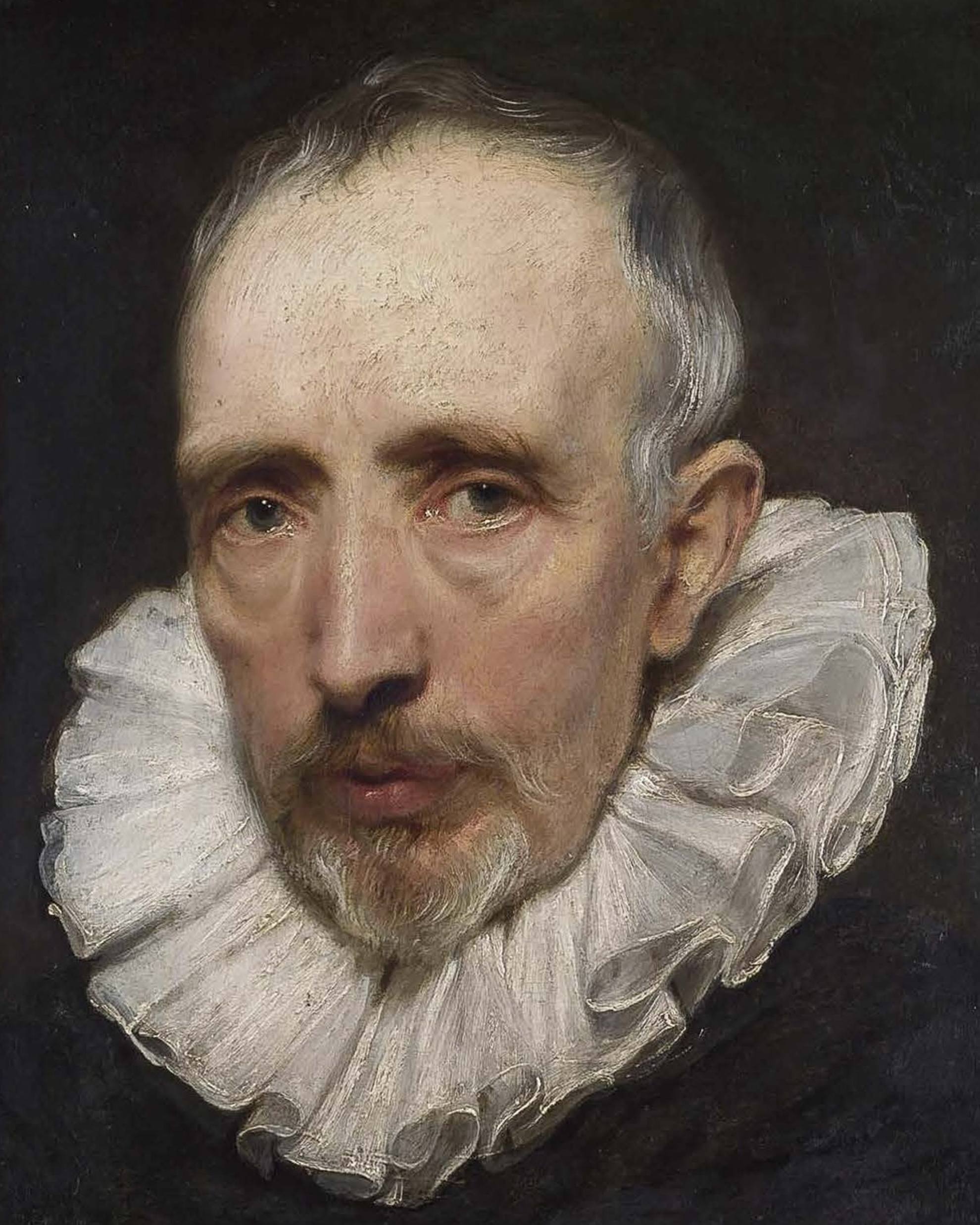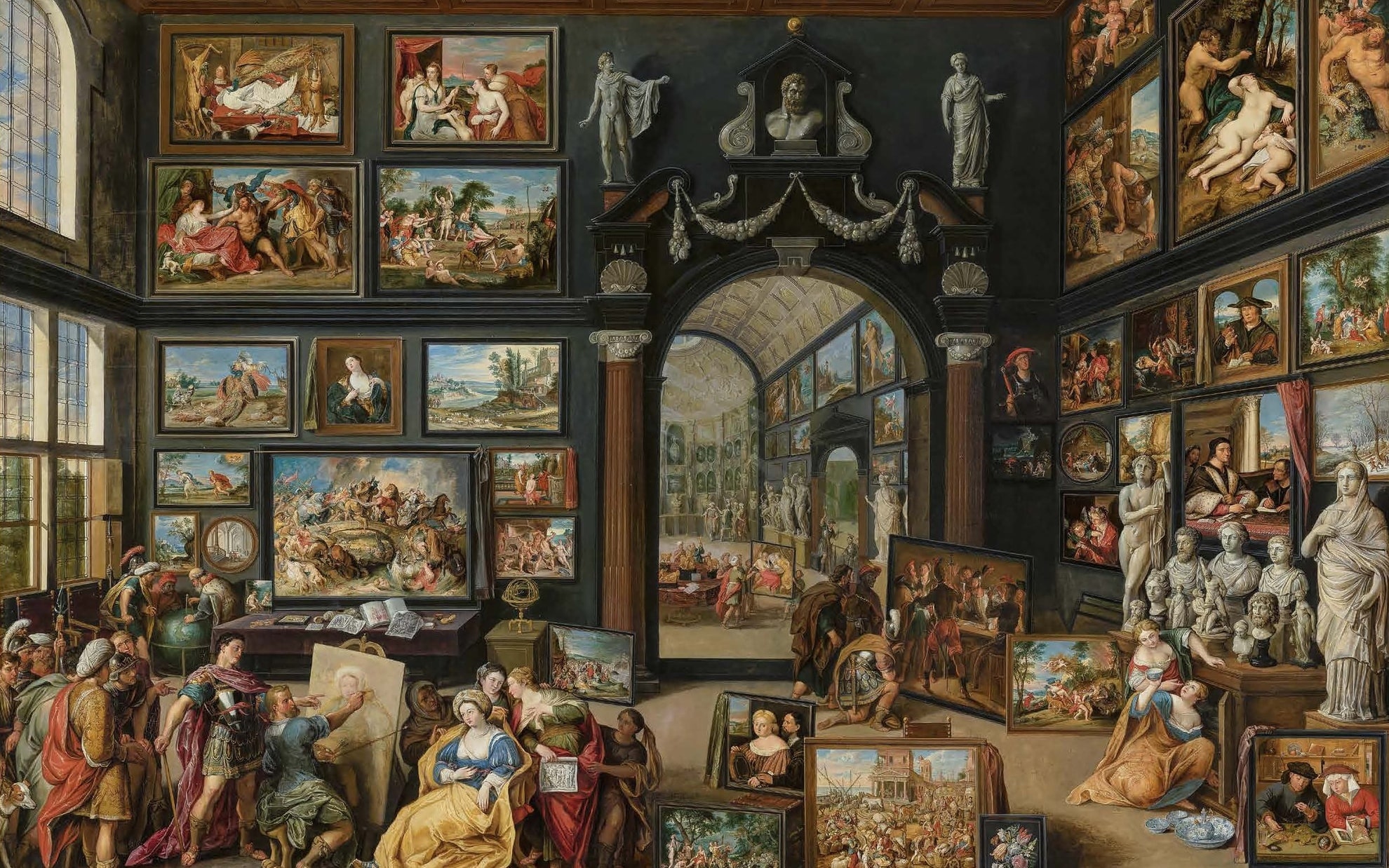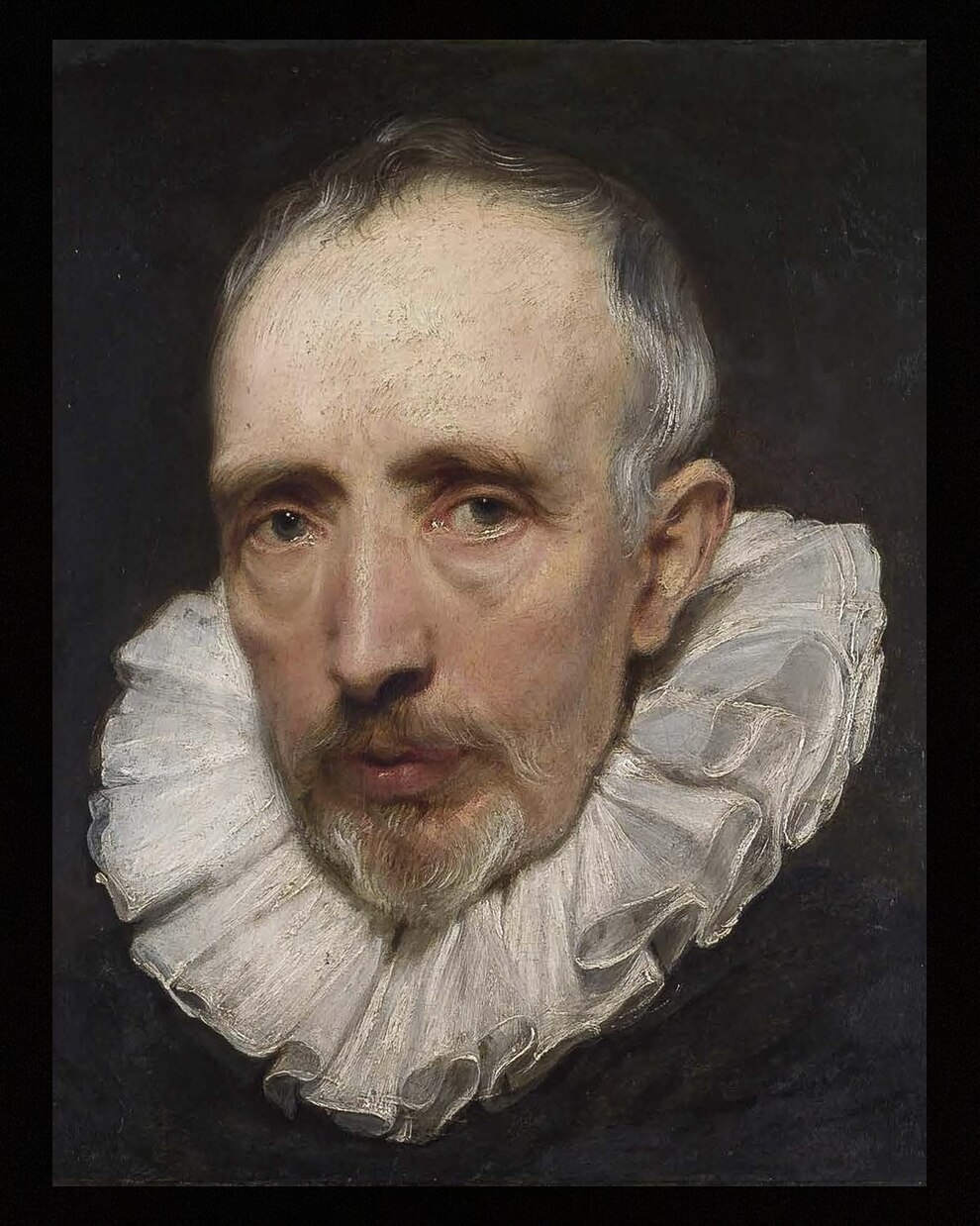
The eye that you see is not
An eye because you see it
But because it sees you.
The human brain is made in such a way as to turn us almost automatically into readers of faces. A single look tells us if the person we see is female or male, young or old, healthy or sick, deranged or sane, local or foreign, unthreatening or violent, cheerful or sad, content or dissatisfied, trustworthy or treacherous… Though we may often be mistaken, in order to live our lives we must cling to this fleeting impression, this passing intuition.
The man depicted, in this case a person apparently on the threshold of old age, does not come to life because we are looking at him. On the contrary, he is alive because he is looking at us, and the way he lives is expressed in his gaze. When he sees us, and we feel ourselves seen, he is far more alive than if we alone were seeing him. So the first thing that occurred to me when I saw him was to say:
His gaze is alive
In front of me.
He is warm, and breathing.
I almost see the breath
Leaving his mouth.
Now, many years after seeing him for the first time, I wonder if it really was breath that I saw leaving his mouth. Perhaps instead his lips parted to tell me something and then, with the caution of his prudent air, he preferred to keep quiet. I knew nothing of him when he first looked at me, but since he did so so intensely, without blinking, he authorized me in a way, and almost insisted that I return his gaze. If your gaze is scrutinizing me, and you are trying to guess who I am, I thought, I will scrutinize you back. I’m not saying that I will come to know you, but I will imagine you. I had an advantage over the portrait sitter: a small caption beside the picture on the wall of the museum gave his name and age, details of the historical context and a brief account of his dual and perhaps contradictory occupations. The man is looking at me, says the National Gallery’s note, from around the year 1620, when the artist who painted him, Anthony van Dyck, was just 21 years old. The caption also notes that the sitter is 65 years old, is from Antwerp, and devotes his life to two trades: one earthly, that of spice merchant, and the other more elusive and ethereal, an art collector and patron of artists.
Intrigued by the man hiding behind that gaze, I wanted to find out more about him by interrogating books and scholars. I discovered that Cornelis van der Geest was a wealthy burgher, single and childless, a patron and a great connoisseur. His own gallery, one of the first great private collections, can be considered a precursor of what would soon become known as the “house of the muses”, or “museum”.1 Notable among his protégés was Peter Paul Rubens, who, on the death of his patron, ordered a print to be made of the first work that Van der Geest commissioned from him (the triptych The Elevation of the Cross, currently in the Cathedral of Our Lady in Antwerp), with the following inscription: “To the best of all men and the oldest of my friends, in whom from my youth I found a constant patron and who throughout his life was an admirer of painting…”. The early and lasting friendship between Rubens and Van der Geest has occasionally prompted the attribution of the portrait to the master of Siegen rather than to his pupil Van Dyck, although the latter’s authorship has been accepted since the end of the eighteenth century.2 There is a clear continuity between Rubens and Van Dyck, which can be detected, for example, in their common admiration of the Venetian school, and particularly Titian.
As far as Titian himself is concerned, what most impressed both men were his precocity and his naturalistic virtuosity, gifts highlighted by Giorgio Vasari: “Not being more than eighteen years old, [Titian] made the portrait of a gentleman of the Barbarigo family, his friend, which was considered very beautiful, the likeness of the flesh-coloring being true and natural, and each strand of his hair being so clearly distinct from the others that it might have been counted, as also might have been the stitches in a doublet of silvered satin that he painted in that work.” (G. Vasari, Lives of the most eminent Sculptors, Painters & Architects… newly translated by Gaston Devere, London 1912-1915, Vol. IX)
Vecellio’s art was such that a light and texture indistinguishable from reality emanated from the faces and clothes of his subjects. So it is not surprising that Rubens repeatedly copied the works of the Venetian master during his travels in Italy and Spain. His most beloved disciple, Van Dyck, did the same, dedicating much time to studying his master’s master during his long stay in Italy (1621-1627).
Returning to the portrait that has obsessed me since I saw it for the first time, the caption in the National Gallery, where it hangs, states that it was painted “around 1620,” that is, before Van Dyck’s journey to Italy and therefore prior to his direct study of Titian’s work. The Flemish painter’s fascination with the Venetian master could have been kindled earlier. Even without seeing his paintings in person, Titian’s brushwork and mastery of light could have entered the imagination and style of Van Dyck through Rubens’ eyes.
All the same, “the true and natural likeness of the flesh-coloring” of Van der Geest’s face, the very fact that we can see “each strand of his hair... so clearly distinct from the others that it might have been counted,” and the clear sensation that the portrait was painted in living color without an earlier sketch, lead me to wonder if the picture might have been made after, not before, Van Dyck’s Italian journey and his detailed study of Titian. I venture this query not just for stylistic reasons but because of what is revealed by the sitter’s countenance: his age, his tiredness, his gaze.
It’s not easy to date the portrait, even if it is asserted almost without exception that it was painted between 1619 and 1621. Stijn Alsteens and Adam Eaker recognize that some of the portraits that Van Dyck produced during his adolescence and early youth (in his first Antwerp period, between 1613 and 1621) possess a strange “Italianate quality,” which is even more curious considering the small number of works of the Venetian school in contemporary Flemish collections.3 According to Alsteens and Eaker, the most likely explanation is that Van Dyck had assimilated the “Italian touch” through Rubens; an explanation, however, which in the case of our portrait is not completely satisfactory. In Icones Principum Virorum etc., the collection of portraits that Van Dyck ordered to be engraved in 1627, at the end of his journey in Italy, Van der Geest also appears. In the etching, the patron appears to be of a similar age as in the oil painting, with a similar posture. This resemblance is evidence of a connection between the etching and the portrait (or its preliminary sketches).
There is complete disagreement about the date of Van der Geest’s birth. According to the caption in the National Gallery, he was born in 1555, making him 65 at the moment he was portrayed by Van Dyck. The database of the Netherlands Institute of Art History (RKD), meanwhile, lists a birth date of twenty years later, 1577, which would mean that the painting represents a man of 43 years old. Other sources give 1575 as his date of birth. As for the date of Van der Geest’s death, all concur on March 10, 1638.
A third portrait of the patron exists (I have only discovered three made during his lifetime), from the same period but a little smaller, in which our character appears inside his own art gallery. The collectors of Antwerp began to exhibit their treasures in halls open to connoisseurs in the first half of the seventeenth century. In the same period, the art galleries themselves became subjects of paintings, among them the extraordinary Kunstkammer van Cornelis Van der Geest, signed by Willem van Haecht in 1628 (oil on panel, 100 x 130 cm, Rubenshuis, Antwerp). Van Haecht was the curator and restorer of Van der Geest’s art collection. He lived for around two years in his patron’s house, and both belonged to the Jesuit Confraternity of Bachelors.
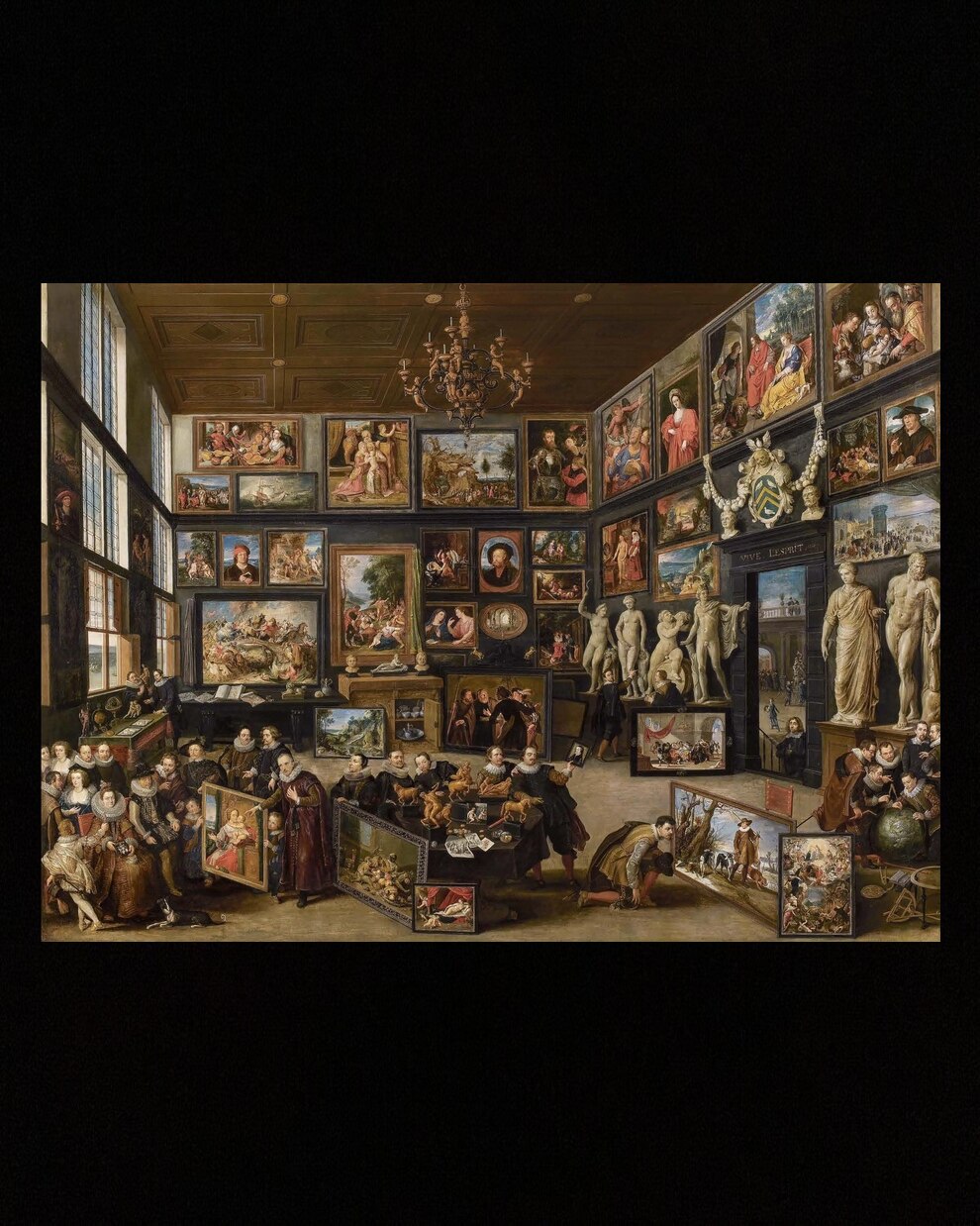
If we look closely at Van Haecht’s Kunstkammer, Van der Geest, whose figure occupies the centre of the composition, doesn’t remotely appear to be 73 years old, as he would have been had he been born in 1555. His features resemble those painted by Van Dyck eight years earlier… but are apparently rejuvenated, as if he were a little over 50 years old, that is, the age he would have been if born in 1577 (in accordance with the information from the Netherlands Institute of Art History). It’s certainly possible that Van Haecht might have wanted to ingratiate himself to his friend by giving him a facelift. The relationship between the two was so close that the painter bequeathed his most valuable works to the collector, who survived him. The visit to Antwerp of the Infanta Isabel Clara and Archduke Albert, which the Kunstkammer depicts, took place in 1615, so it’s possible that the painter might have wanted to portray Van der Geest as a man who was 13 years younger. Far from being a naturalistic work, the Kunstkammer is characterized by abundant inventions and symbolism. Everything suggests a fabricated scene, including the presence of Rubens and Van Dyck in prominent positions (as befitted the patron’s favorite artists). Everything… except perhaps the figure of Van der Geest.
Regardless of its verisimilitude or lack thereof, the presence of Rubens among the illustrious guests of the Kunstkammer, as well as his respectful attitude towards the patron, give rise to puzzling questions. If our portrait dates back to 1620 as stated, it would be strange for a client of Van der Geest’s stature to have ordered his portrait from a young talent (the youngest in Antwerp) and not from his friend Rubens, the artist he most supported and protected, and to whom he gave many lucrative commissions. In fact, as far as I know, no portrait of Van der Geest exists among the known works of Rubens (nor is there any record of such a portrait having been lost).
This makes me wonder if it is not more likely that the patron commissioned his portrait when his life was nearing its end. There is a resigned melancholy in the sitter’s expression that is clearly not that of a young person. Considering his advanced age – 65 years if Van der Geest were born in 1555 and the portrait dated back to 1620 – it makes sense that he would have thought of Rubens, rather than Van Dyck. Nor may we forget that in 1620 Rubens was living in Antwerp, was in the prime of his working life and owed many favors to his patron. This leads me to a slightly risky speculation. Rubens left Antwerp repeatedly, sometimes for more than a year. When? Precisely when Van Dyck, on his return from Italy, established himself once more in his native city, not moving from there for five years, from 1627 to 1632, as if occupying the vacuum left by his mentor. These years coincide with a period of intense diplomatic activity for Rubens, who, as is well known, had friendships in all the European courts. It was then that he took advantage of his connections to promote the cause of peace between Protestants and Catholics, whose wars had brought Antwerp and much of the Low Countries to the brink of ruin. On this premise, I wonder if it may be appropriate to reconsider the date of the portrait. Is it not more probable that Van der Geest, already elderly, commissioned this portrait from Van Dyck during the long – too long – absence of his esteemed friend Rubens? Probable or not, it is a futile question, since scholars agree that Van Dyck portrayed Van der Geest between 1619 and 1621, before traveling to Italy. Be that as it may, the birth date of the patron is wrong somewhere: either in the National Gallery or in the Rubenshuis and in several encyclopaedias. If the sitter were born in 1577, Van Dyck’s portrait cannot be from 1620 since he appears to be an old man, not a 43-year-old. On the other hand, if he was born in 1555, why should Van Haecht, in 1628, have painted not a 73-year-old but a man who appears to be 20 years younger?
My doubts, conjectures and related research have led me this far. Now I would like to return to the moment in which I saw Van der Geest’s portrait for the first time, half a century ago, in all the naïveté of my 19 years. I didn’t care then about dates or art history, and I knew nothing of the influence of the Venetian school on Rubens and Van Dyck. What mattered to me then was to guess at what the portrait sitter expressed, what the portrait – a simple mixture of color, light and shade – and its caption afforded to my intuition, my inventiveness and my imagination. Nothing else.
Looking at the portrait of a close relative, we can tell whether the artist has managed to capture not just his physical aspect but also his intimate likeness, the expression of his character. But if the sitter is unknown, it’s impossible to judge the physiognomic faithfulness of the portrait. In this case, our task as observers is the reverse: to reach an understanding of the sitter’s character through his representation. This implies trusting the artist’s ability to depict the subject in an intimate manner, almost as if we knew him.
It is half a century now since I first saw Van der Geest’s portrait. The years fill us with information and knowledge, but they rob us of a capacity for intuition and guesswork. To recover the innocence, let us say the virgin state of looking, I have invited a young Italian friend to the National Gallery, Marina, who is a third my age and is untrained in the reading of works of art. She has the ingenuousness that I might have had at her age. I ask her to tell me what she sees in case it resembles anything of what I saw and recorded in an old poem.
I wait for a while as she looks and is looked at by Van der Geest. At last, Marina says to me: “He is tired, pale, tentative, disenchanted and self-aware.” I ask her to use fewer adjectives and more nouns. She agrees and continues: “He knows he’s close, that’s why his lips seem as if they had wanted to speak but they do not. He has caused disappointment, and he knows it. He spent some time tidying his beard, he has a sense of his appearance, but a pounding in his heart; he is very lonely; all the beauty was not enough. He has always slept little, he has lain awake thinking, and he has felt the cold, well, he has felt so cold that he has the typical pallor of someone who is very cold. Not a single color, but pallid. He has shiny, wet eyes, like when the wind makes your eyes water.” “Perhaps it is not the wind,” I suggest. She appears doubtful, and then adds something very important that I had seen, but not smelled: “He has put on some perfume, for sure.” “Perfume? How do you know?” I ask. “You can see it between the beard and the collar. There is perfume there, take a look! It is a discreet, cold, slightly blue perfume, like your grandparents’ aftershave, a lotion.” “An eau de Cologne?” I ask. “Yes, a cologne,” she replies. She falls silent. I ask her: “Anything else?” She looks, thinks, allows herself to be seen. She finishes: “Wait, one more thing: he is deliberately ambiguous.”
Leonardo Sciascia notes that “when physiognomic truth is captured and transformed in expressiveness, that is, in the moment in which the subject expresses himself most fully, in which the light of his eyes and the fold of his lips tell what we already know about his life, his actions, his thoughts and his work, the portrait acquires an even stronger likeness and the interpretation becomes even more reliable.”4 On the other hand, when the subject is unknown to us, then, if we wish to know his character, his thoughts, his works and his life, we have no alternative but to depend on the portrait. The fidelity of Van Dyck’s brushes is borne out by the other two portraits of Van der Geest mentioned earlier. But the comparison between them is not enough to establish whether the painter succeeded, and to what extent, in capturing the “expressiveness” of the sitter. To determine this, we must appeal to our faculty (an exclusively human gift) of reading the mind through the face, the appearance and the expression.
What does our intuitive mind read in this portrait? Just as the two hemispheres of the brain are dedicated to distinct vital, rational and emotional functions, so the human face, even though it tends towards symmetry, is never perfectly symmetrical. Each half of the face, in a certain sense, expresses distinct aspects of the same personality. In the portrait of Van der Geest we can see a duality noticed both by Marina, who calls it “ambiguity,” and by Efrain Kristal, the famous Hispanist, who has helped me bring this topic into clearer focus. The same duality that I captured in my first eye contact with Van der Geest, and that I expressed in a poem built precisely on the tension between the affluent merchant and the lover of beauty: on one side, the industrious and practical man, on the other, the man fascinated by the eternal sense of art. According to Kristal, the expressions of the two sides of Van der Geest’s face represent two types of sadness and two types of tiredness, just as the mouth shows a type of energy absent from both, perhaps because of the presence of the dark circles under his eyes. In my opinion, we see in the collector’s face the juxtaposition of body and spirit.
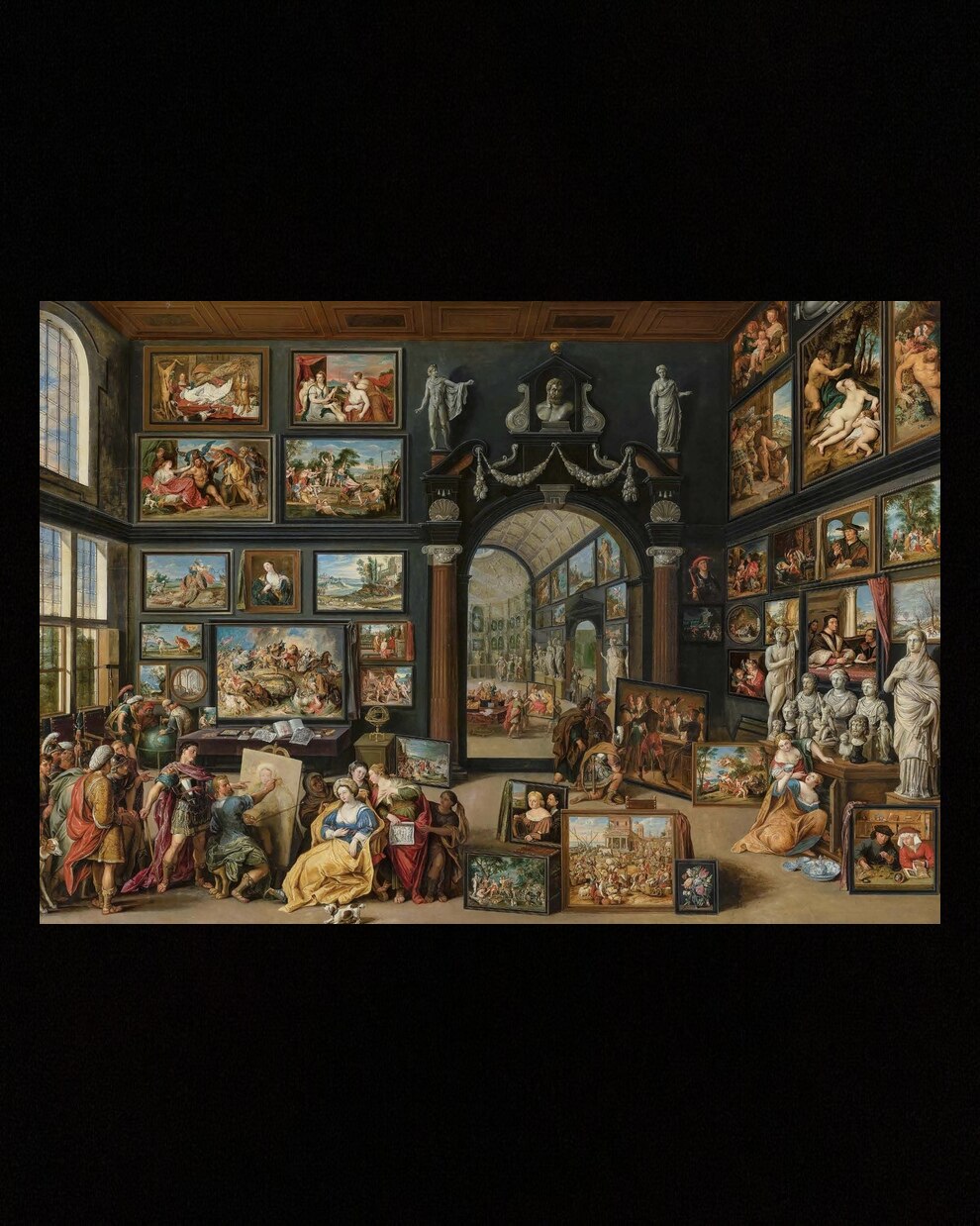
In the divided face of Van der Geest the body/spirit juxtaposition is reflected as if Van Dyck had painted it under the influence of the Catholic and Platonic dualism typical of the age of the Counter-Reformation. Returning for a moment to Van Haecht’s Kunstkammer, we can make out above the door of the gallery a skull, a dove and a motto – Vive l’Esprit – that clarifies the significance of the adjacent symbols based on the play on words “esprit” / “geest” (which in Flemish means “esprit” or “spirit”): the Spirit (symbolized by the dove) overcomes Death (that is, the skull) just as Van der Geest will triumph over the ephemerality of things through his love for beauty and art.
One of the most surprising and moving features of Van Dyck’s portrait is the fact that air, or breath (the spirit, or perhaps a word) appears to be coming out of the half-open mouth of the patron. In the poem that I composed at that moment, knowing nothing of dates or influences, neither Van Haecht’s Kunstkammer nor Titian’s portraits, the same doubleness perceived by Kristal and Marina reverberates: an echo of the imaginary voice of Van der Geest.
Before transcribing my poem, I will mention one final doubt. The frame that surrounds the portrait in question has a peculiarity: the lower part is much taller than the upper part, because it covers an additional panel, apparently added years later, as if a different artist had wished to enlarge the portrait so as to turn it into a bust by adding the hands or a part of them to the sitter’s face and ruff. What remains hidden is an extended thumb apparently pointing at the face. On the thumb we see a fine white brushstroke identical to those that delineate the sitter’s eyes so expressively. Are we sure that Van Dyck did not make this addition? Might it then be Van Haecht who wanted to make his friend and benefactor more complete and fashionable? I have no answers. On the back of the panel there are no signatures or inscriptions, just a kind of monogram that seems to represent the letters MV, or perhaps only a W, maybe the W of Willem; and below, the trace of two crudely sketched hands, or something similar. I don’t know what this means, but it adds a hidden charm to the fascination of the portrait. A portrait that I will never tire of looking at, just as I will never tire of it looking at me, because while it still does I will feel it, and I will feel alive.
Here, finally, is the poetry inspired by that first and far-off eye contact:
His gaze is alive
In front of me.
“Remember me!” he says.
He is warm, and breathing.
I almost see the breath
Leaving his mouth.
And that mouth speaks to me:
“I was a spice merchant
And patron of artists.
I commissioned the youngest of
Antwerp’s talents
At the age of just twenty-one
And by the name of Van Dyck,
To trace with his brushes
My northern countenance.
I was almost an old man.
My skin, made lank
By too many
Sleepless nights,
Hung from my cheekbones;
My hair, now grey,
Sparse and fine;
I had that rather unsound look,
Dull and pallid,
And an ascetic gauntness
Bestowed neither by fasting
Nor illness,
But by the hours and the days,
The weeks and the months,
The years and the decades,
Irreparable time;
But I knew how to carry
My faded autumn
With a certain dignity.
I knew that nothing of me
Would remain but this picture.
And so I say, look at me!
It is I,
Who gave the best of his fortune
To the fine arts.”
And I look at you,
Cornelis van der Geest.
You know already that commerce and wealth
Will not make you immortal,
But the portrait will.
I have never seen a look
Painted better than yours.
Tears spring to your eyes
And to mine.
I cry with you,
Cornelis van der Geest.
Héctor Abad Faciolince
translation by Matthew Shorter
BIBLIOGRAPHY
- At least three pictures of this gallery, partly idealised, have been preserved, all by the gallery’s curator and restorer Willem van Haecht, and they are: Collection of Cornelis van der Geest with Paracelsus, Appelles painting Campaspe and The Gallery of Cornelis van der Geest. We consider the latter below.
- In 1833, the art historian J.D. Passavant (Frankfurt 1787-1861) attributes the portrait to both, and considers that the face is by Rubens and the clothing (including a part of the bust now hidden by the frame) by Van Dyck.
- Stijn Alsteens and Adam Eaker, Van Dyck, The Anatomy of Portraiture, The Frick Collection, Yale University.
- Leonardo Sciascia, Cruciverba, Torino, Einaudi, 1983.
